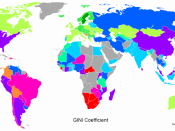STEREOTYPING IN THE MEDIA:
A response to Gregory Mantsios' essay Media Magic: Making Class Invisible
For decades media has helped stratify culture by serving as a means to inform the public of the occurrences that take place in our society. "The mass media is arguably the most influential in molding public consciousness" (Mantsios 101). The more media plays a prominent role in highlighting situations in our society the more media stereotypes become inevitable. Stereotypes in the media usually classify individuals by their class, ethnicity, occupation, gender, and sexual orientation, giving the audience a generalized ideal of the characteristics of a particular group. However, Mantsios' essay Media Magic: Making Class Invisible focuses on the segregation of the middle-class and under-class, creating a division between one another, where "we" or "us" the middle-class are humiliated by "them" the under-class. False representation of the under-class and the victimization of the middle-class by the under-class are two points continuously exemplified in the media today.
The media has a tendency "to focus on the plight of the poor, these stories are about middle-class opposition to the poor. Such stories tell us that the poor are an inconvenience and an irritation" (Mantsios 103).
In a recent article titled Closing the Education Achievement Gap, the government is to make a major provision to the 1965 Elementary and Secondary Education Act. The Act will provide $200 billion dollars, from "our" pockets, to schools with children from low-income families. The goal of the revision is to raise the achievement of children in low-income schools to those in higher-income, predominately white, families.
When reading over the editorial and reviewing the photograph that accompanied the article, it was evident that the term "low-income" was portrayed by grueling neighborhoods populated by ethnic and visible minorities. The photos portrayed are a false representation...


